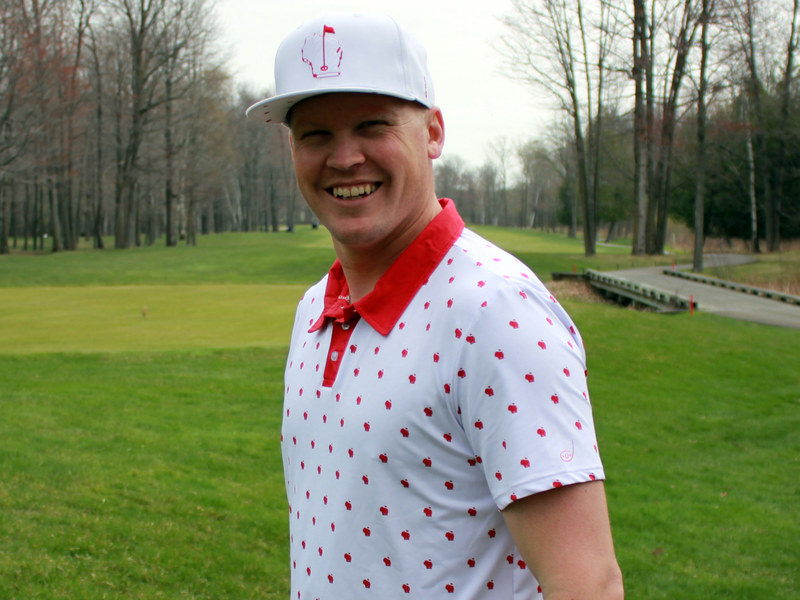Hanging on the wall of the Blackwolf Run clubhouse is a celebratory photograph of Se Ri Pak and the 1998 U.S. Women's Open trophy. Forever 20, Pak smiles widely, exhaustively. It took the then-LPGA Tour rookie 92 holes to best American amateur Jenny Chuasiriporn to win her second consecutive major championship and start a revolution.
That photo greets you as you walk down the stairs to the locker rooms at Blackwolf Run, where Se Ri Pak visited late this spring.
"I'm Se Ri Pak, but I'm basically born in 1998 U.S. Open at Blackwolf Run in Wisconsin," she said.
Girls in South Korea were awoken in the dark hours or watched Pak's victory on tape delay the next morning, then rushed to small driving ranges – stepping over all other interests.
Since that Monday in Kohler, and including Pak's other majors, a South Korean woman has won two LPGA Championships, two Kraft Nabisco Championships, three Women's British Opens and four U.S. Opens.
"All the Korean media called us 'Se Ri's kids' because every time we were watching her game and we grew up playing," said Na Yeon Choi, the world's fourth-ranked player.
The tournament had a global, lasting impact on the women's game but it also its share of individual moments that affected those who participated, and watched.
OnMilwaukee.com interviewed many of the key participants for an oral history of several key moments in the most influential women's golf tournament in the last 15 years.
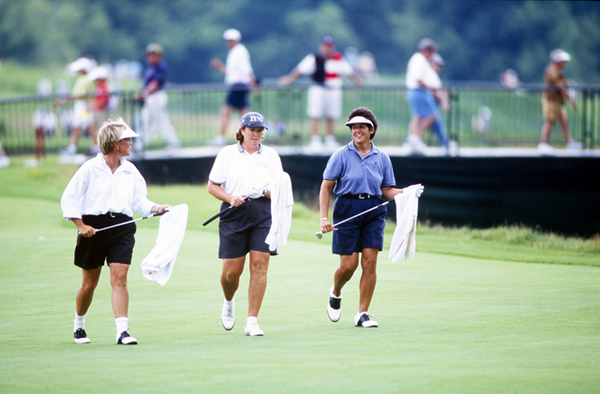
The White Flags
Nancy Lopez entered the 1998 U.S. Women's Open in search of her first national championship and was coming off second place finish to Alison Nicholas the year before at Pumpkin Ridge Golf Club in Oregon.
The World Golf Hall of Famer had already won three major championships, but the U.S. Open was her white whale, having finished runner-up four times and in the top 10 in four others.
At 41 however, it was becoming clear her window for winning a U.S. Women's Open was closing.
Lopez was paired in the first two rounds with Jane Geddes, the 38-year-old 1986 U.S. Women's Open champion, and 35-year-old Meg Mallon, winner of the 1991 U.S. Women's Open.
All three felt it was a tournament they could win – until they struck their first shots on Thursday.
Lopez: We tee off on the first hole. Jane Geddes hit first, hit down the left center of the hole, and Meg hits it dead right into that stuff over there on the right hand side, and I hit mine down the left center of the hole.
And so Meg starts to try and hit out of that stuff, and she hits her first shot, and it hits a tree and it goes further in the stuff, and I'm like holy cow. And I'm watching her, and you're in the U.S. Open - you don't want to see that on the first hole. So I went on, and I hit my shot up on the green, because the USGA official came and she told us to go ahead.
I kind of walked on up, and then I watched Meg hit again and not get out again. And so I decided to keep walking up to the green, because I was really not enjoying that. I felt so bad for her. And so I went on up, and then I can't see them anymore, but I see Jane hit. I see her ball up in the air, but it didn't get on the green. So I'm like what is going on down there? I didn't want to see it, so that's why I stayed at the top.
And I remember my caddie, Tom, looked down at me, and he says, he knew I was feeling uneasy, and he says, can I get you anything? I said, you got two valium? Geddes: It must have taken us 45 minutes to play the very first hole of the tournament, which got us all off to a very bad start. And we still joke about it. By the time we got the green, which was forever, and it was Nancy's turn to putt and her caddie had to kind of get her out of a fog. I think we were all just stunned. We still laugh about it because I remember kind of looking at her going 'Nancy, Nancy, it's your turn.' It's one of those golf courses where you get going and you get in trouble and you're thinking let me just get out of this hole.
Lopez: As we were walking to the second hole, we were all just kind of shook up a little bit, and Meg says, you know, you work all year to get to the U.S. Open, and you make a nine on the first hole. That is tough to deal with. So it was pretty much, we were all trying to get each other kind of uplifted, because it was a downer after that first hole.
And when you're on a golf course like Blackwolf Run, and you've already just fell apart after number one, you've got a long road ahead of you. And we ended up not playing very well. If I hit a green, I couldn't putt. Just too much thinking. The course made me really, really think too much when it was pretty automatic when I got here.
Geddes: It looked like we hadn't even played a practice round. I'm sure we played numerous, but it was just a very, very strange week for the three of us to be in the same group, unfortunately.
On Friday, the trio looked to a fresh start. With the USGA's 10-shot cut rule in effect, and first round leader Laura Davies at only 3-under, Lopez, Mallon and Geddes felt the cut could be made and they could climb back into the tournament.
Shortly into the round however, such optimism disappeared completely.
Steve Steinhardt, the group's Friday standard bearer: It's the kind of golf I always play – in the rough, out of the rough. You don't expect that. I look at it two ways – that's what I do all the time so I feel your pain, but I also feel your pain because you're not used to that. It is difficult to watch.
Lopez: That year, the LPGA Tour had a logo, motto, whatever you want to call it, of, hey, we can play. I'll always remember that. That was the slogan for that year: Hey, we can play. Well, as the day goes on, we get to number, I think it was 14, and I was sitting there thinking, wow, you know, this is the first hole in two days that we've all been on the green in regulation, all three of us. And we're pretty good players, but we hadn't been on a green in regulation together until 14 on Friday.
So we're all getting ready to putt, and the caddies were up there. And I walked over to the girls, I said, do you all realize this is the first time we've been on the green in regulation together, the three of us? And Meg looks up, and she says, hey, we can play. We all, the caddies, and we just started laughing, and I think the crowd was like, okay, they're losing it, because they're playing so bad. But it was an uproar of laughter because of what Meg said.
Geddes: That was probably the point where we all loosened up enough to actually laugh about something short of saying 'Oh, God, we're going to miss this cut.' And at that point in our careers, none of us were missing cuts. If you missed a cut, one or two in a year, you were bummed.
Steinhardt: I don't know that it ever got to the point where it was jovial. I remember we were on the 16th tee and it was a par 5 and there was a group in the fairway in front of us, so we had to wait, and I remember Nancy turning her back to the hole and just kind of gazing. I think she realized at that point it was over. There was just a blank look in her eye, like she knew it was done. I don't think it got jovial until they came up the 18th fairway.
Geddes: We know what our fate was going into the last hole. You keep your head down and you plod away because you're competitive and you have people following you and don't want to make a mockery of what you're doing, but I remember teeing off on 18 and walking off the tee and at that point we're all 'alright, we're almost done.' So, we were all walking off together so I said to both those guys we should all get our towels and we should wave the white flag walking down this fairway.
Lopez: I'm like, I'm all for that, because I'm so glad I'm missing the cut. It was just so tough.
Steinhardt: I'm walking down the fairway and all of a sudden you hear the crowd and you're going 'what's that all about' and you turn around and they're all pointing and you just kind of chuckle. That's all I could do. They just had fun with it at that time, I guess.
Geddes: At the moment it seemed like a funny thing to do. Little did we know it would be in Sports Illustrated and all different places. Honestly we just were doing to the USGA, really, saying OK, we give. Three top players at that time and it beat us. Definitely. That was the point. It was really tongue in cheek. It was sort of a salute saying this was a brutal golf course. Like I said, maybe she would've. Maybe Meg wouldn't have, but it was funny in the moment. We didn't realize it was going to be sort of an iconic thing. Pak took the 36-hole lead at 3-under while American amateur Jenny Chuasiriporn, a Duke University junior, finished the day four shots back at 1-over.
The course toughened on Saturday as winds began to swirl, with Pak shooting a 4-over 75 but Chuasiriporn remained four shots back.
On Sunday, Pak was in the final group and paired with Mhairi McKay. Chuasiriporn and Lisolette Neumann would go off just ahead of them.
The day was brutal, and black numbers mounted.
Chuasiriporn shot a 1-over 72 highlighted by a 40-foot putt on the 18th hole. She walked off the green with no idea of where she stood in the tournament as Pak began her march down the last hole.
Jenny Chuasiriporn: I didn't. That was the weird thing. They didn't reveal the scoreboard at that time. I think Se Ri, I can't remember, I think she was 2 shots up and she had 17 or 18 to play or something. Then I didn't know she bogeyed 17. They didn't flip her score up on the 18th scoreboard while I was playing. So in my head I was like I'm two shots back, let me just finish this hole. It wasn't until I finished the putt and was in the scoring trailer that I'm watching her putt and they have my picture on the bottom screen when they look for your reaction. I turned over, what? What is she putting for? What's her score right now? That's when Pat Hurst was like 'She's putting to win and if she misses, you'll tie.' That's when I realized like 'what?' I think that was my 20-year-old innocence. I had always been like that. I always just played and just tried to focus on what I'm doing. That helped.
Joey Chuasiriporn, Jenny's brother and caddie: As we were waiting for Se Ri to finish, I was still watching green side and I think Jenny was in the scoring tent. I saw her play the 18th and remember that she was pretty close for birdie, so she still had a chance to win it outright. Even until after the round ended though, I don't remember what I was thinking, but I do remember all the blood still rushing to my head and goose bumps all over. Everyone wanted an interview because Jenny might have been in the TV booth by then, but even my little brother at the time was doing interviews. That was funny. Pak missed an 8-foot birdie putt that would have won the tournament outright, sending her into a playoff with Chuasiriporn after a final round 5-over 76.
Pak: Me and her, just the two of us, starting Monday morning. Sunday night after I finished my first impression was, again? Again? Eighteen holes? This golf course? I just finished, I was so tired and I was like really? Four rounds had been really like four months. So difficult, so hard, so much pressure, so much stress. It was so hard. The other (side) is you have a chance to win. I had dreams about it. So, excited at the same time oh, again. Eighteen holes. I don't know how I can finish that. Well, I mean, as long as you win, you have to be there and you have to fight for it.
Chuasiriporn had to find a new place to stay Sunday night, finding a nearby bed and breakfast to crash at. Pak, scheduled to play the Jaimie Farr Tournament in Ohio the next week, had planned to stay to Monday as it was.
Pak: So Sunday night, back to the hotel, we got dinner. My whole family was there that week, my mom and dad fly from Korea, so having dinner, and my dad said 'just go out tomorrow, just do your best.' And he's already happy. For me, the same thing. I was being happy for me to be in this situation, it doesn't matter what happened on Monday, but I will, no matter what, it's going to be a great experience for me. My dad has always say that too, just go out and do your best, this is most grateful. So Sunday night, same thing, same routine, relax, have dinner and go back to sleep.
Except for both women, rest would be hard to come by.
Pak: Trying to go to sleep, I laid down on the bed and thinking about each single hole and how to play, what did I do for the last four rounds. A couple holes actually I have to make sure to be careful. If I miss, miss in the right way. Just trying to make a whole plan for tomorrow, for Monday. Of course, you just can't sleep because a big day is coming up. It's pretty hard to back to sleep. Trying to think, hole by hole, so I think all night I was thinking, to prepare for the Monday round and do the right thing. Of course I wanted to win that badly, and Jenny was the same way, so all I needed to do was make sure I'm preparing for myself and getting ready for tomorrow because it's not only one hole, you need to do 18 to play. It's going to be a long day, no matter what, it's going to take maybe an hour but it's still going to be a long day.
So, I'm trying to, as much as I could, to be out focused but at the same time trying to play my own game instead of thinking too much that, too much this, it's not going to help. So Sunday night all this I'm totally emptying my full head. Monday morning before teeing off all I need to be is at the golf course, playing. That was my whole plan for me on Monday.
Jenny Chuasiriporn: It was definitely hard to sleep. I also thought about the holes, too. You think about hole one, and this is going to be my shot and you're shot goes through until you just fall asleep. it didn't take me too many holes. I think I remember writing in my journal and just kind of saying 'Wow, tomorrow I am actually playing to win the U.S. Open.' Just those thoughts racing through your head. Definitely very hard to wind down that night because it was just so crazy. It was a cool...I had my family around me so it was really cool. It was very surreal. Two women, 18 holes, one trophy. Monday playoff tickets were $10. Pak and Chuasiriporn were to tee off at 11 a.m., with gates opening at 9 a.m.
All week the players had commented on the size of the galleries, which set U.S. Women's Open attendance records. Ticket were being scalped outside the gates, and course owner Herb Kohler himself had to mow a field prior to the weekend to accommodate the unanticipated overflow of cars.
That said, this was Monday – an unexpected development and a workday. It was hard to anticipate the crowd size.
Pak: I was at the range and I feel like hm, maybe today is not going to have too much gallery because it's Monday, beginning of the week, everybody goes to work, so it's going to be a little quiet but it's OK, we have to do whatever we have to do. And after practice on the range I saw some galleries, but it wasn't really much as I expected.
Then, as the two women stood on the first tee, they were overcome, and brought back into the moment.
Pak: I said, 'Oh my God.' It's probably – I think it is the most gallery in the U.S.Open I think, the last 14 years – that day is the most, that crowd of people, and TV wise the same way I think. I was on the tee like, there's so many...there's no rough! It's just fairway and fans. So we were walking and all the fans, 18, now 20 holes. Every shot, I mean...fans so much out there rooting.
Jenny Chuasiriporn: That was crazy. I've never seen a women's tournament like that. I don't know if they've have ever been to one that huge. The people - I remember it so vividly. Every single tournament I've played in my life I've never compared to the people, the crowd, the energy and the excitement that they had in Wisconsin. I can't even believe it. I can't imagine how they would replicate that. Kids, parents, families and grandparents. Everyone was out there it seems like. Early in the playoff, Chuasiriporn raced out, moving to 3-under through five holes to take a 4-shot lead. Pak began to reel her in however, and the two were even heading to the 18th tee. But then Pak found the water hazard left of the green. Rather than drop, Pak shed her socks and shoes and took her stance.
Kohler: I've got the former President and Finchem in tow, who's here because of the opening of Straits, and the first thing that happens right in front of us, Se Ri goes in the water. Well, my God. And then to watch her study the situation, finally come to a conclusion to step down into the water, and the water is about two-thirds of the way up on her calves. But considering the way this woman is built, I knew she could, whatever was going to, however she was anchored, it would be stable.
Joey Chuasiriporn: Right after seeing her tee shot go left, I thought our chances were really good, but I had no idea if it went in the water or not. Then, when she was contemplating what to do, I had no idea what her lie looked like at all or even if she had a shot whatsoever. I do remember her taking a longtime though. At this point, I still thought par was going to be easy for us since jenny was sitting in the middle of the fairway. I was feeling great about our position even after Se Ri hit her shot back into the fairway. I knew up and down for jenny was more realistic than Se Ri getting up and down from the fairway. When Jenny hit her chip, I knew it came out a bit fast and hoped it would slow down close enough. But, after Se Ri missed her par putt, I really liked our chances especially when Jenny was putting and especially after what happened the day before.
Na Yeon Choi, the world's No. 4 ranked player: I was only nine years old and I started golf, so I watched the golf, and I still remember that feeling.
Pak chopped out, opening a window for Chuasiriporn to win the championship. The 20-year-old had to get up-and-down from just off the green to win, but chipped about 10 feet past the hole and missed the comebacker.
Jenny Chuasiriporn: The last hole, when she was in the water and then my approach shot was over the green and all I had to do was get up and down to win. I think that shot was my ... my adrenaline ... put it to 10 feet still. I just remember that putt coming back. I really hadn't missed a whole lot of putts the whole week and I looked down and my hands were just, I couldn't even hold on to the grip, my hands were shaking. Obviously that's probably why I missed the putt. I think that was what I remember the most, I guess.
Pak, standing ankle deep in the hazard, was memorable for many. But it was her skin tone that made an impression in her native South Korea.
So Yeon Ryu, the 2011 U.S. Women's Open champion: The Korean time and the American time is different, so actually that moment I was in my bed. I didn't see it. I saw Se Ri on the news. It's pretty impressive. Se Ri had the tan line on the socks - it was really a surprise for me. Actually, on Tuesday we had the P.E. program in the school so we tried to have the tan line or whatever but we don't have it. Our practice ranges have just a little bit of grass on the ground so we tried to hit the ball on the ground but Se Ri hit the really thick grass, but our grass is not thick grass, it's little short grass. It was not similar but we just tried it. We were so proud of Se Ri because she was Korean and a Korean won the US Women's Open. I think that's a really great memory.
Choi: She showed to all the Korean people she made her dream. After that, a lot of people, even not golfers – a student, anybody – can have bigger dreams. It's really hard to explain to American people, but (my friend is) not a golfer. She's just a student. But she remembers, too. She remembers her foot, when she took the socks (off) and walked to the water, like really white and dark. That showed to all the Korean people how much she practiced hard, how much time she spent on the golf course under the sun. That impressed all the Korean people. It doesn't feel like it, but the U.S. Women's Open at Blackwolf was not the first major championship for Pak, who won the LPGA Championship a little less than two months earlier.
Yet it was the combination of the Monday playoff drama, Pak's tenacity, and the significance of the tournament on a global scale that created a seismic shift in the women's game.
Ryu: Lots of broadcasts came to our elementary school 'oh what do you think about Se Ri's win?' So it let me know that actually the kids liked the interview with the broadcasts, is really excited and was a little more interested in golf. At the moment Korea's economy was really bad, but Se Ri gave me hope for every Korean. Everybody loves Se Ri. Even I am a really big fan of Se Ri. She's my idol star. But now I'm playing with her, so how amazing! I can't believe it!
Pak: 1998 is the most great of memories for me and my whole country. So many people actually memorized that morning, that day. For my country, fans the first thing they said was oh, 1998, US Open, that was a great tournament, I watched, and it was so fun, I was so proud of my country. Every single memory of 1998 – is here - still.
Kohler: It was our first one, so obviously it had a lot of weight, because it started so many things. But it had more weight because it inspired so many people. It inspirited a nation, literally. You see the result today with all these players.
Hurst: It definitely opened up the door for a lot of the Koreans to come over and see that Se Ri can do it, put in the time and I want to be just like her. That's what they've done. They've heard how much she works at it and what she would do and they all, all of them, look up to her. She was a stepping stone for all of them.
Choi: She inspired a lot. All the Korean players. I mean, I'll tell you this. I went to my first tournament before she won with only six people my age. But after she won, a lot of people started golf, so next tournament after she won, like 48 people started to go, same age. Like Jiyai Shin, Inbee Park or I.K. Kim, they watched Se Ri Pak on TV and then they started golf. But me, I started a little earlier than them, but that much was a big power to all the Korean players.
I think a lot of Korean people didn't believe a Korean could win on the LPGA Tour. This is a world tour, right, a lot of countries, a lot of good players come to here to play golf. No one could think a Korean could win, but she did. After she won, even me, my dream was only like being a professional golfer. But when I watched her play, when she made the winning, I changed my goal – actually my father and me changed our goal – to we have to go there, we have to go to the LPGA and try to win. That is our goal. I think she makes all the people bigger dream. The tournament didn't only change the game of women's golf, but it changed the sport in Wisconsin. Including this year's return to Blackwolf Run, Herb Kohler's golf properties have hosted five major championships are booked for the 2015 PGA Championship and 2020 Ryder Cup at Whistling Straits. Erin Hills in the Town of Erin hosted the 2011 U.S. Amateur will welcome the world at the 2017 U.S. Open.
Pak, 34, a World Golf Hall of Famer with five major and 27 total LPGA Tour victories, on missing the winning putt in regulation: Of course, I want it to be really easy to win. That's what everybody wants. You don't want it to be so difficult. But that moment, that shot, I missed it, and then a whole history is started. I don't think if I made it and I won as Open champion, but it's not going to be a memory. That's why it was a great experience, a moment. I said because of the shot, I missed it, I'm here. I'll take that.
Chuasiriporn, 34, now a ICU cardiac unit nurse in a Richmond, Va. hospital: It's been a little bit difficult just recalling the event or recalling the feelings and recalling specific shots or specific circumstances of the event. I haven't even watched the event since the event. Even NBC did a little thing on me too that they plan on airing during the weekend, so that was a nice little flashback. Honestly it's surreal, so I kind of forgot all the details – how many strokes you were up and those kinds of things, those kinds of details. Overall, it brings back great memories. It hasn't been a nuisance whatsoever.
Joey Chuasiriporn, 35, is now a product manager for TaylorMade-adidas in Asia: Because I am still in the golf business, I have had to keep up to date with the golfing world every week. When people see my name, there is almost always someone reminding of that tournament and where they were watching the event during that time. It is always a good ice breaker for me, and I am extremely lucky to have had that front row seat so that I can relive every moment of that USWO. For my sister to watch however, I know it must be really hard because she was so close to making history of her own. It's easy for me because I did not have to hit any shots that week, but my sister did, and at that time she was at the pinnacle of her golfing career.
Kohler, 73, remains president and chairman of Kohler Company: Well, it was such a dramatic impact, this whole thing, on me, on the company, on our opening at Whistling Straits, and then to have a conclusion like we had with these players, it was a fairytale that you couldn't write. You couldn't make up. So the impact was, I hope it doesn't happen again, frankly. This poor old fellow can't stand it.
Lopez, 55, never won an U.S. Women's Open or another tournament: After I played (a practice round), I was like, oh, my gosh. You know, maybe it would've been better if I didn't, because I was afraid of the course a little bit. And, you know, I had won a lot of golf tournaments, and it intimidated me quite a bit. So when I left here, I kind of lied to everybody. I said it's really a great golf course, and it is tough. But I didn't want to tell them that it was going to kill me, so I tried to be positive. But that was the experience I had that day that I played my first practice run here, and, but it was, you know, as I say, it kicked my butt, definitely.
Geddes, 52, and now Vice President of Talent Relations for World Wrestling Entertainment, on the white flag moment: I think because we were respected players and we all had good careers and we actually recovered after that. It didn't blow all of our careers. It was a moment in time for us, a week in our careers that just so happened we lived it together. It definitely wasn't our proudest U.S. Open but in the end we were able to laugh about it and say we'll move on from that and way to go USGA. It was a doozy. It really was. I think if would have ruined one of our careers, because sometimes moments like that or weeks like that have detrimental effects on people and their careers and that definitely was not the case with us. We all went in thinking we could win the tournament, and I guarantee we teed it up the next week thinking we could win that tournament. It was really a moment in time. It just so happened it was a good photo moment for a lot of people.
Hurst, 43, on whether 1998 US Open was a bellweather for the women's game: "I think that's you guys saying that. I know with me, there are different markers for me. I would have to say it's not the Open or what have you. There are some tournaments or some players will say 'that was my year.' It isn't for me, there, I have to say. 1998 was one of my best years so the whole year for me in particular was a fun year and I remember playing some good golf. It was a lot of fun being in the thick of things a lot of times. For me that was a great year in general."
Steinhardt, 54, is now the chairman of the standard bearers: The waving of the white flag, you kind of look at it and chuckle, and I didn't think at the time that that would be the image that everybody remembered. I guess at the time you don't even know you're a part of history, so to speak.
Ryu, 22, who will defend her title this week: It's huge. It's huge. Se Ri is a Korean golf icon and everybody that remembers this moment, so this event is really, really huge for Koreans.
Choi, 24, considered the top South Korean player to have not yet won a major: She is still my idol. A lot of Korean younger players, we call her Legend. She is still my idol and she is a good role model. I think she changed a lot of things in Korea, especially golf and women's golf. We have to be very thankful to her for what she did, not only Se Ri Pak but Mi Hyun Kim or Grace Park. I think if they are not in here, we couldn't be here today. So we really have to appreciate.
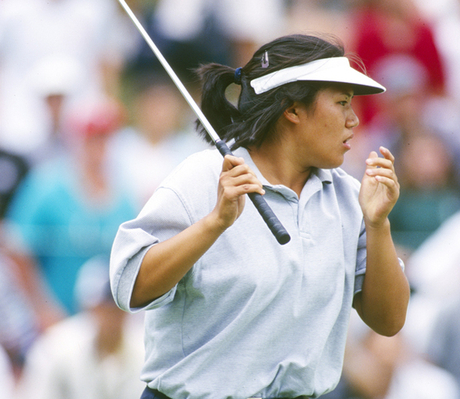
The end of regulation
Shocked to reality
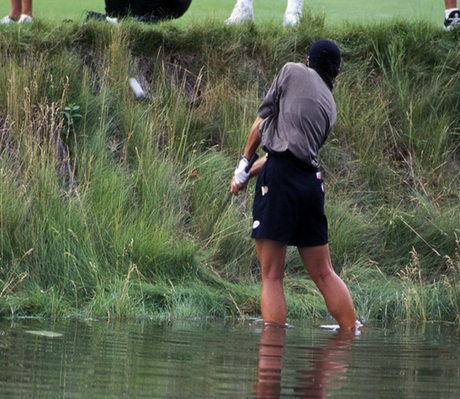
The Water
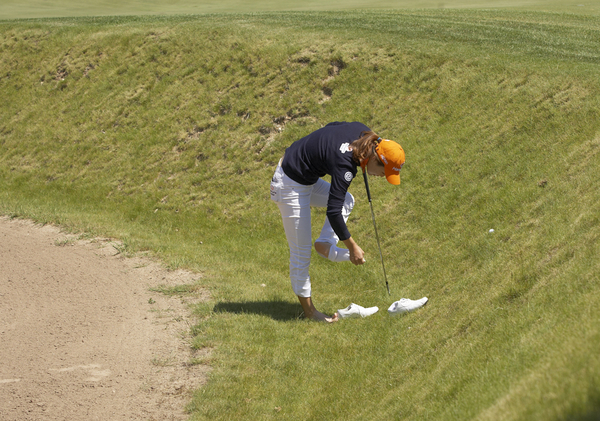
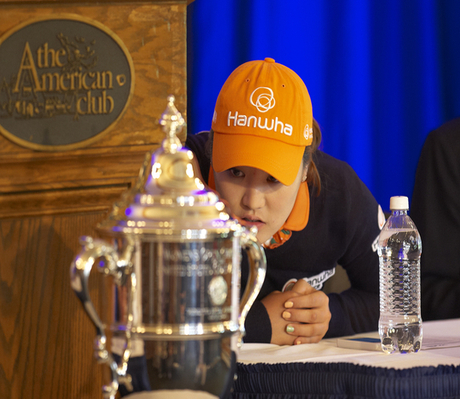
The world turns
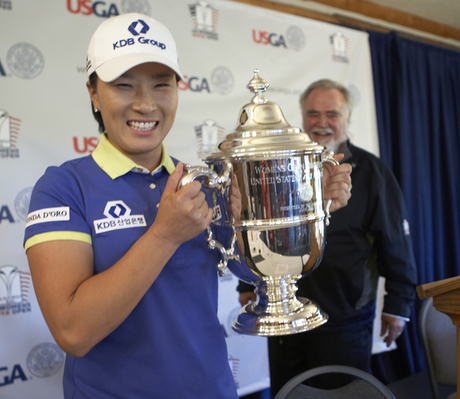
Postscript
Jim Owczarski is an award-winning sports journalist and comes to Milwaukee by way of the Chicago Sun-Times Media Network.
A three-year Wisconsin resident who has considered Milwaukee a second home for the better part of seven years, he brings to the market experience covering nearly all major and college sports.
To this point in his career, he has been awarded six national Associated Press Sports Editors awards for investigative reporting, feature writing, breaking news and projects. He is also a four-time nominee for the prestigious Peter J. Lisagor Awards for Exemplary Journalism, presented by the Chicago Headline Club, and is a two-time winner for Best Sports Story. He has also won numerous other Illinois Press Association, Illinois Associated Press and Northern Illinois Newspaper Association awards.
Jim's career started in earnest as a North Central College (Naperville, Ill.) senior in 2002 when he received a Richter Fellowship to cover the Chicago White Sox in spring training. He was hired by the Naperville Sun in 2003 and moved on to the Aurora Beacon News in 2007 before joining OnMilwaukee.com.
In that time, he has covered the events, news and personalities that make up the PGA Tour, LPGA Tour, Major League Baseball, the National Football League, the National Hockey League, NCAA football, baseball and men's and women's basketball as well as boxing, mixed martial arts and various U.S. Olympic teams.
Golf aficionados who venture into Illinois have also read Jim in GOLF Chicago Magazine as well as the Chicago District Golfer and Illinois Golfer magazines.






